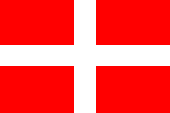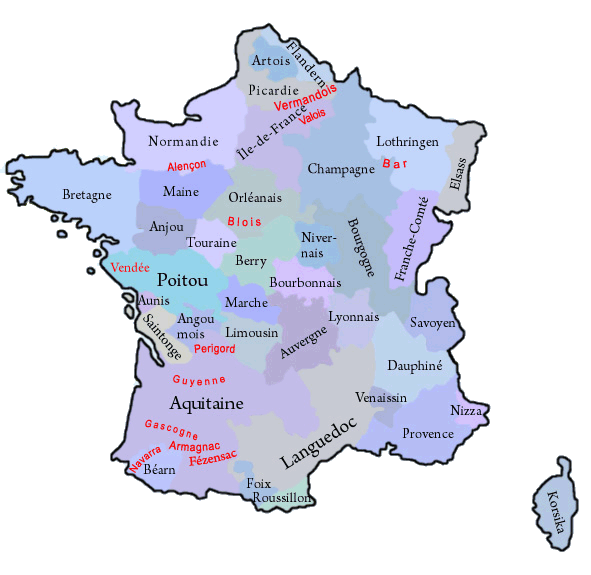mobile View, to the German Version tap the flag


- historical region in today's France
- former county, duchy and province
- own name in French: Savoie
- own name in Savoyan: Savouè
• Flag
• Meaning/Origin of the Flag
• Coat of Arms
• Meaning/Origin of the Coat of Arms
• Map of the historical Regions in France
• Explanations about the Regions
• Numbers and Facts
• History
• Origin of the Country's Name

Flag of Savoy
– Drapeau de Savoie,
Source, by: Wikipedia (D)






The flag of Savoy shows the image of the coat of arms, coming from the 14th century, a white cross on a red background.
Source:
Volker Preuß


14th century
Coat of arms of Savoy
– Blason de Savoie,
Source, by: heraldique.org

14th century,
WCoat of arms of Savoy as imperial vicars
– Armoiries de Savoie en tant que vicaires impériaux,
Source, by: heraldique.org

The coat of arms of the House of Savoy - and later of the country of Savoy - shows a white cross on red background. It was probably awarded to the dynasty in the 14th century, when the Counts of Savoy ascended to princes of the German Empire. One symbol of the Empire was the black eagle on golden ground, which reappears in the arms of Savoy as imperial vicars, another - especially in this time - the white cross on red. The eagle also appeared again and again, until modern times, on a heart shied in the coat of arms, and sometimes even on flags of the Kingdom of Sardinia-Piedmont (until 1861).
Source:
Volker Preuß

The historical, French Regions:

in black: governorate and province in 1776,
in red: former county, province oder governorate
Map: Volker Preuß

The until the French Revolution existing provinces (or governorates) have been historically grown structures, which had their roots oftenly in former fiefdoms of the French crown, historic counties and duchies. They oftenly existed for hundreds of years and had preserved regionality (e.g. cultural particularities and regional languages). On the occasion of the French Revolution such phenomena were of course not desirable, and as part of their bloody and violent egalitarianism any regional references were eliminated. Shortly after the French Revolution the provinces were dissolved and France became divided into many départements, which should have approximately the same size and the same status. The départements were named after rivers or mountains, to use never and in no circumstances the name of an old province. However, there was no success in cutting the connections of the people of France to their respective regions, so that administrative regions were re-created in 1960, to have a better control in regional administrative processes. In this way became départements, which were placed in a historical province, administratively grouped to an oftenly historically named region. The resulted structures coincide only approximately with the boundaries of the old provinces. In the strictly centralist France any regionality is avoided, so that even the official flags of these regions mostly look like flags of companies, unloving, unhistorical, technocratic and modernistic, and these flags should not be a subject of any lexical considerations here. Only in a few of that regions, exist official flags which remember the historical models. But, even the existence of these today's regions is douptful, because in 2014 was passed a territorial reform valid from the year 2016, that reduces the number of the existing regions by merging to nearly the half. However, there exist unofficial flags in nearly all of these regions, which should remember the old provinces and the old heraldry.
Wikipedia Link to the regions of France:
click or tap here
FOTW Link to the regions of France:
click or tap here
Source: Flags of the World,
Wikipedia (D),
Volker Preuß

Area: 4.022 square miles
Inhabitants: 1.250.423 (2018)
Density of Population: 311 inh./sq.mi.
Capital: Chambéry
Languages: French, Savoyan, Arpitan
Time Zone: GMT +1h
Source: Wikipedia (FR)

antiquity · Settlement by the ancient Celtic tribe of the Allobroges
121 B.C. · conquest by the Roman Empire, to the province of Alpes Vallis et Graiae Poeninae
443 · settlement of Burgunds by the Roman Empire
534 · conquest by the Franks
814 · death of Charles the Great (King of the Franks and Emperor of the Holy Roman Empire)
843 · inheritance disputes, contract of Wirten (Verdun), the Frankish Empire is divided among the three grandsons of Charles the Great, Lothar I. gets the middle kingdom, consisting of "Lotharingia" (from Burgundy to Friesland), Burgundy and Italy
870 · Treaty of Meersen, Svoyen comes to the Kingdom of Italy
879/880 · Treaty of Verdun and Ribemont, Savoy comes to Upper Burgundy
934 · Savoy comes to the Kingdom of Burgundy, belonging to the County of Vienne
1023 · the Archbishop of Vienne Vienne acquires the county
1025 · Humbert I. acquires the Aosta Valley, the County of Vienne gets divided, the northern part comes to Humbert I. in fief
1032 · Savoy is part of the Holy Roman Empire (of German Nation)
1033 · Humbert I. is Margrave of Piedmont (thats why the dynasty is later called even Savoy-Piedmont)
1125 · the descendants of Humbert I. call themselves Counts of Savoy and become independent from the seigniory
1232 · acquisition of Pinerolo and Chambéry, Chambéry becomes the residence of the Counts
1269 · conquest of Vaud (in today's Switzerland)
1313 · the Counts of Savoy become princes of the Holy Roman Empire of the German Nation
1349 · the Dauphiné comes to France
1361 · Emperor Karl IV. solves Savoy from the old Kingdom of Burgundy (Arelat) and subordinates it directly under the Emperor
1365 · the Counts of Savoy become imperial vicars of the Arelat
1388 · acquisition of the County of Nice
1401 · acquisition of Geneva County (but not the city of Geneva itself)
1416 · the Counts of Savoy become dukes
1534–1536 · loss of territories in today's Switzerland (Geneva, Valais, Vaud)
1536–1559 · Savoy is annexed by France, the residence of the Dukes is moved from Chambéry to Turin
1601 · Western Savoy - western of Rive Rhone - (Bresse, Bugey, Valromey und Gex) is ceded to France
1701–1713 · Spanish War of Succession
1714 · Peace Treaty of Utrecht, the House of Savoy acquires the Kingdom of Sicily
1718 · in exchange for the Kingdom of Sardinia, Sicily comes to the House of Savoy
1720 · unification of Savoy-Piedmont with the Kingdom of Sardinia, the title of King of Sardinia comes in this way to the Duke of Savoy, establish of the Kingdom of Sardinia-Piedmont by the House of Savoy
1738 · acquisition of Novara and Tortona
1792 · invasion of French revolutionary troops
1796–1815 · annexed by France
1814/15 · Congress of Vienna, reorganization of Europe after the Napoleonic era, restoration of the Kingdom of Sardinia-Piedmont, the Republic of Genoa gets annexed by Sardinia-Piedmont
1848 · in almost all of Italy uprising of the people's movement "Giovine Italia" under Mazzini and Garibaldi, Charles Albert of Sardinia-Piedmont sets himself at the top of the uprising, the Italian uprising ends in disagreement
1859 · Italian War of Independence against Austria, the Lombardy gets annexed by Sardinia-Piedmont
1860 · Guastalla, Parma, Modena, Tuscany and the Romagna become annexed by Sardinia-Piedmont, Savoy and Nice were to cede to France, Savoy gets divided into the départements of Haute-Savoie and Savoie
17th of March 1861 · coronation of Victor Emmanuel II. of Sardinia-Piedmont to the King of the Kingdom of Italy
1960 · reintroduction of regions in France, Savoy doesn't play a role, affiliation with the newly created Rhône-Alpes region (capital: Lyon), of course not within the historic boundaries, just by integrating of the departments of Savoie and Haute-Savoie and merge withe the departments of Ain, Ardèche, Drôme, Isère, Loire and Rhône
2016 · the Rhône-Alpes region merges with the Auvergne region in the new, larger region of Auvergne-Rhône-Alpes (capital: Lyon)
Source:
Wikipedia (D),
Atlas zur Geschichte,
World Statesmen

The name "Savoy" goes back to the ancient Celtic name of the region. The Celts called the land "Sapaudia", what means "wood land".
Source:
Wikipedia (D)


![]()







